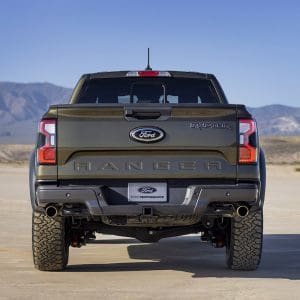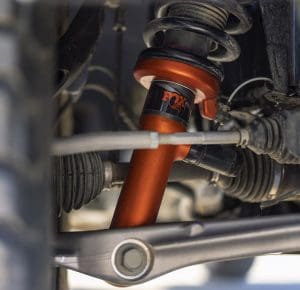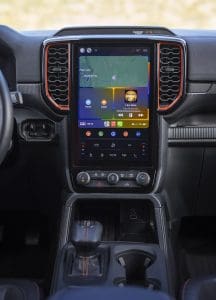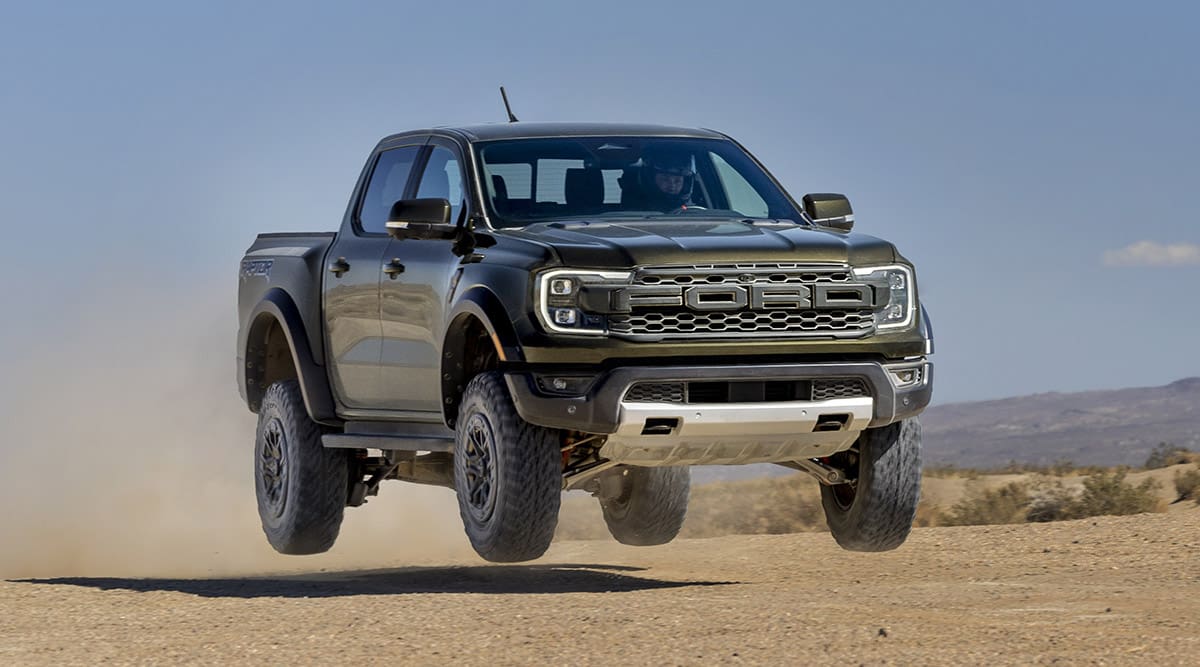When people think Ranger, they usually envision a small two-door utilitarian pickup truck used by auto parts stores to deliver goods to mechanics around town. The latest generation Ranger has matured and takes its cues from the larger F-150. So, when the latest Ranger Raptor with the SuperCrew cab arrived, I was surprised by its relative size compared to the F-150. The Ranger Raptor measures around 210 inches in overall length, while the F-150 Raptor measures 232 inches. Twenty-two inches is nothing to sneeze at, but I was pleasantly surprised by how spacious the new Ranger Raptor is in the passenger compartment.
 Whether navigating tight off-road trails or maneuvering through the parking lot at the local mall, the Ranger Raptor may fit the mission even better than the original king of off-road pickup trucks. Carl Widmann, the chief engineer of Ford Performance, summed it up nicely: “Ranger Raptor is the high-performance off-road truck so many customers have been begging for. It’s right-sized for tight trails and daily life, can carry lots of gear, and is a blast to drive. Ranger Raptor is fast, comfortable, and packed with top-shelf, purposeful technology that’s designed to perform. This is the baddest Ranger we’ve ever made.”
Whether navigating tight off-road trails or maneuvering through the parking lot at the local mall, the Ranger Raptor may fit the mission even better than the original king of off-road pickup trucks. Carl Widmann, the chief engineer of Ford Performance, summed it up nicely: “Ranger Raptor is the high-performance off-road truck so many customers have been begging for. It’s right-sized for tight trails and daily life, can carry lots of gear, and is a blast to drive. Ranger Raptor is fast, comfortable, and packed with top-shelf, purposeful technology that’s designed to perform. This is the baddest Ranger we’ve ever made.”
No Joke Off-Road Hardware – Ranger for Danger!
 The Ranger Raptor features a fully boxed frame. The suspension is connected to the solid foundation through next-generation Fox 2.5-inch Live Valve Internal Bypass shocks. This setup uses coil-overs at the front and piggyback reservoirs at the rear, which, according to Ford, reduce heat build-up for uninterrupted performance all day long. The Fox Live Valve Internal Bypass system changes damping performance based on Ranger Raptor’s Drive Modes. The modes include Normal, Tow/Haul, Sport, Slippery, Off-Road, Rock Crawl, and Baja, all developed to provide better on-road comfort, off-road control, capability, and ride quality at high and low speeds.
The Ranger Raptor features a fully boxed frame. The suspension is connected to the solid foundation through next-generation Fox 2.5-inch Live Valve Internal Bypass shocks. This setup uses coil-overs at the front and piggyback reservoirs at the rear, which, according to Ford, reduce heat build-up for uninterrupted performance all day long. The Fox Live Valve Internal Bypass system changes damping performance based on Ranger Raptor’s Drive Modes. The modes include Normal, Tow/Haul, Sport, Slippery, Off-Road, Rock Crawl, and Baja, all developed to provide better on-road comfort, off-road control, capability, and ride quality at high and low speeds.
The selectable drive modes adjust the tuning of the engine, transmission, ABS calibration, traction control, steering, throttle response, and even the instrument cluster and touchscreen look and information. The active valve exhaust system can also be tuned to several modes, including Quiet, Normal, Sport, and Baja settings. The differences among the four aren’t as dramatic as the F-150 Raptor R, but I had a good time toggling between the Quiet and Baja settings (just those two settings would do the trick for me). The Ranger Raptor also comes with Trail Control so you can navigate tricky spots while the ECU manages the throttle and brakes.
Smaller Truck, Big Power
The Ranger Raptor is driven by a 3.0-liter twin-turbo V6, which produces 405 horsepower and 430 lb-ft of torque. One of its cool party tricks is the anti-lag turbo system, usually found on rally cars. When you put the Raptor into Baja mode, it keeps the turbochargers spooled up for up to three seconds after the driver backs off the throttle. This way, you get instant acceleration when exiting corners. The engine is paired with Ford’s proven ten-speed automatic transmission.
Interior Goodies
The interior is enhanced with Code Orange color accents like other Raptors. The seats are supportive yet comfortable, holding you in place if you get jostled by a rough trail. The infotainment system features a portrait-style large 12-inch touchscreen. I prefer the landscape-style touchscreen found on the Bronco, but the climate control adjustments remain in the same place at the bottom of the screen, so you don’t have to hunt for them. The screen allows you to access the camera system with a great 360-degree camera and a front view camera.
 The Ranger Raptor features a Bang & Olufsen sound system with ten speakers driven by a 660-watt amplifier. According to B&O, “to ensure the listening experience from a stationary car is maintained while driving, regardless of the conditions, the cabin undergoes over 1,200 hours of static and dynamic sound tuning for different cabin variations.” It sounds good, but it could use a bit more bass due to the dedicated subwoofer driver being only 5.5 inches. An aftermarket subwoofer would enhance the system’s ability to compete with the Baja exhaust setting.
The Ranger Raptor features a Bang & Olufsen sound system with ten speakers driven by a 660-watt amplifier. According to B&O, “to ensure the listening experience from a stationary car is maintained while driving, regardless of the conditions, the cabin undergoes over 1,200 hours of static and dynamic sound tuning for different cabin variations.” It sounds good, but it could use a bit more bass due to the dedicated subwoofer driver being only 5.5 inches. An aftermarket subwoofer would enhance the system’s ability to compete with the Baja exhaust setting.
The Ranger Raptor is one of those vehicles that combines utility, performance, off-road ability, and fun into one platform. Moreover, with that iconic large FORD front grille, people will know you opted for the bad boy in the lineup. With a starting price of $55K, I would look in this direction over an F-150 XLT with a few options and get a fully loaded, ready-to-rock Ranger!

